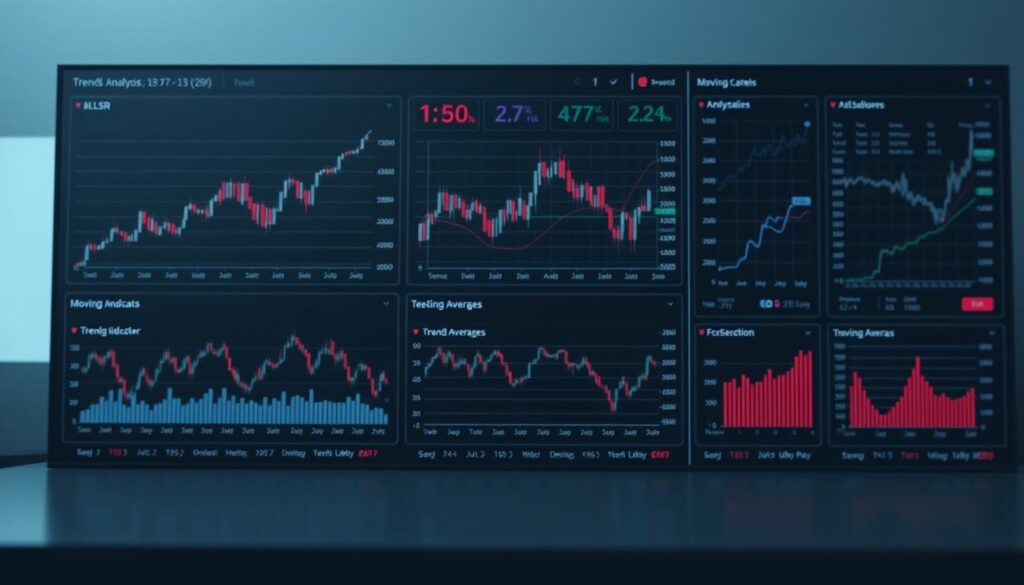Now Reading: Accurate Neural Network Cryptocurrency Volatility Prediction Strategies
- 01
Accurate Neural Network Cryptocurrency Volatility Prediction Strategies
Accurate Neural Network Cryptocurrency Volatility Prediction Strategies

The world of digital assets moves fast. Prices can swing wildly in very short periods. This makes understanding market movements a top priority for investors and analysts.
Since Bitcoin’s launch, the market has grown to include thousands of different coins. This expansion created a need for better forecasting tools. Traditional financial models often fell short when applied to these new markets.
This led to the exploration of advanced computational methods. Machine learning and deep learning offered new ways to analyze complex price data. These techniques can find patterns that older models might miss.
This report looks back at how these sophisticated approaches have evolved. We examine their historical performance and the key innovations that improved their accuracy over time.
Key Takeaways
- Digital asset markets are known for their significant and rapid price changes.
- Traditional forecasting methods struggled with the unique nature of crypto markets.
- Advanced computational techniques provided a more effective solution for analysis.
- Different architectural designs were developed to handle various types of market data.
- Incorporating additional data sources, like market sentiment, enhanced the performance of these systems.
- The field has seen consistent progress, leading to more reliable forecasting tools.
Introduction
From niche technological experiment to global financial phenomenon, digital assets have followed an extraordinary trajectory. Since Bitcoin’s 2009 debut, the cryptocurrency market has expanded to include over 22,000 different coins with a total valuation exceeding $1.15 trillion by mid-2023.
This rapid growth created a trading environment with distinct characteristics. Digital currency markets operate continuously without closures, feature decentralized structures, and show strong sensitivity to social media sentiment. These factors contribute to price movements that far exceed traditional asset fluctuations.
Early attempts to analyze cryptocurrency price patterns relied on conventional time series approaches. However, researchers quickly discovered these methods struggled with the complex, nonlinear nature of digital asset data.
This limitation prompted exploration of advanced computational techniques. Machine learning methods and deep learning architectures offered significant advantages by adapting to complex patterns without restrictive assumptions. They could process diverse data sources including trading volumes and market sentiment indicators.
The importance of accurate forecasting extends across multiple stakeholders. Individual traders, institutional investors, and regulators all benefit from reliable predictions. This analysis, as detailed in recent financial research, examines how various analytical approaches have evolved to meet these challenges.
Cryptocurrency Market Evolution
Beginning with a single innovative technology, the digital asset ecosystem expanded into a complex financial marketplace. This transformation created new opportunities while introducing unique challenges for market participants.
Bitcoin’s Emergence and Market Growth
Bitcoin launched in 2009 as the first decentralized digital currency. It introduced blockchain technology and peer-to-peer transactions without intermediaries.
The cryptocurrency market experienced exponential growth through multiple cycles. From negligible early value, Bitcoin reached above $60,000 in 2021. Total market capitalization grew to approximately $1.15 trillion by May 2023 across more than 22,000 digital assets.
Evolution of Digital Assets and Trader Behavior
Digital assets diversified beyond simple payment tokens. The ecosystem now includes smart contract platforms, DeFi protocols, and specialized blockchain applications.
Trader behavior evolved from early technology enthusiasts to include institutional investors and corporations. This heterogeneous investor base contributed to complex market dynamics that traditional models struggled to capture.
The changing landscape created sophisticated demands for forecasting tools. Machine learning and deep learning methods emerged as promising approaches for analyzing these evolving patterns.
Overview of Cryptocurrency Volatility
Market analysts quickly discovered that traditional financial models were inadequate for understanding digital currency fluctuations. The price swings in these markets reached levels that far exceeded conventional asset classes.
Daily price movements of 5-10% became common during certain periods. This contrasted sharply with the typical 1-2% daily changes seen in stock markets.
Characteristics of Extreme Market Fluctuations
Several factors contributed to these unprecedented market movements. Limited liquidity compared to traditional markets played a significant role. The 24/7 trading environment without circuit breakers allowed price swings to continue uninterrupted.
Social media sentiment often drove rapid price changes. Regulatory announcements and technological developments also triggered immediate market reactions. These elements combined to create a uniquely volatile trading environment.
High-frequency intraday data provided more accurate volatility measurements. Traditional estimators based on daily returns proved insufficient for capturing the true scale of market movements.
Price instability tended to cluster in extended periods. High-volatility conditions could persist for weeks before transitioning to calmer market phases. This pattern challenged conventional forecasting approaches.
Accurate market analysis became crucial as derivatives markets developed. The launch of Bitcoin futures in 2017 increased demand for reliable forecasting tools. These tools supported risk management and portfolio optimization strategies.
Review of Traditional Forecasting Models
The first systematic efforts to predict price fluctuations in digital markets utilized traditional time series methodologies. Researchers turned to established econometric frameworks that had proven effective in conventional financial analysis.

GARCH and HAR Model Insights
Early studies applied various GARCH family specifications to major digital assets. Chu et al. (2017) found IGARCH and GJR-GARCH provided the best statistical fits. Katsiampa (2017) identified AR-CGARCH as optimal for Bitcoin analysis.
The heterogeneous autoregressive approach showed particular strength for short-term forecasting. Bergsli et al. (2022) demonstrated HAR’s superiority over GARCH families for immediate horizons. This model used lagged realized volatility across daily, weekly, and monthly frequencies.
Limitations in Capturing Nonlinear Dynamics
Despite their application, traditional forecasting methods faced significant constraints. Charles and Darné (2019) revealed fundamental incompatibilities between GARCH frameworks and Bitcoin return characteristics.
These econometric models struggled with extreme nonlinearity and sudden market shifts. Their parametric assumptions limited adaptability to complex digital market dynamics. This prompted exploration of more flexible analytical approaches.
Introducing Neural Network Solutions
Complex market dynamics demanded more flexible analytical tools than traditional models could provide. This need led researchers to explore advanced computational approaches that could adapt to rapidly changing conditions.
Machine learning algorithms offered significant advantages over conventional statistical methods. They could process diverse data types without requiring strict assumptions about underlying distributions. This flexibility proved particularly valuable for analyzing digital asset markets.
Deep learning architectures represented a major advancement in analytical capabilities. These systems used multiple processing layers to automatically extract meaningful patterns from raw data. The approach enabled discovery of complex relationships that simpler models might miss.
| Model Type | Key Advantage | Data Handling | Application Era |
|---|---|---|---|
| Traditional Econometric | Statistical Rigor | Structured Data Only | Early 2010s |
| Basic Machine Learning | Pattern Recognition | Multiple Data Types | Mid-2010s |
| Deep Learning Systems | Automatic Feature Extraction | Complex Unstructured Data | Late 2010s-Present |
The development of accessible programming frameworks accelerated adoption of these techniques. Tools like TensorFlow and PyTorch made sophisticated learning algorithms available to financial researchers. This accessibility coincided with growing computational power through GPU advancements.
These systems demonstrated particular strength in processing heterogeneous information sources simultaneously. They could integrate price history, trading volumes, and external market factors into unified analytical frameworks. This comprehensive approach marked a significant improvement over previous methods.
Neural network cryptocurrency volatility prediction
A distinct research field developed when computational methods were applied specifically to measure and anticipate digital market turbulence. This specialized area emerged around 2018-2019, separating from general price analysis.

Early approaches used historical price data, trading volumes, and realized instability measures as inputs. These systems learned complex relationships between past market behavior and future fluctuations.
Most studies through 2021 incorporated additional predictors as separate variables. However, they failed to explicitly model interactions between digital and traditional financial markets.
A critical limitation was the inadequate handling of multiscale properties in financial data. Market dynamics differ significantly across various time horizons, requiring specialized modeling approaches.
The “black-box” problem presented another challenge. Complex transformations through multiple layers made it difficult to understand which features drove specific forecasts.
Advanced architectures began incorporating attention mechanisms to address interpretability issues. These allowed models to assign different weights to various input features and time steps.
Research increasingly recognized cross-market spillover effects. Studies documented how Bitcoin’s instability was influenced by traditional markets like stocks, commodities, and bonds.
Graph Neural Networks in Volatility Forecasting
Financial markets operate as interconnected networks where assets influence each other through complex relationships. This understanding led to the development of graph-based approaches for analyzing market dynamics.
These systems represent different assets as nodes in a graph. The connections between them capture how price movements in one market affect others.
Dynamic Graph Structures in Financial Markets
Market relationships constantly evolve rather than remaining static. Deep learning frameworks can adapt to these changing conditions automatically.
The connections between digital assets and traditional markets shift over time. Regulatory changes and economic events reshape these relationships continuously.
Multiscale and Cross-Market Interactions
Different time horizons reveal distinct patterns in market behavior. Short-term relationships often differ significantly from longer-term connections.
Advanced systems can analyze interactions across various time scales simultaneously. This provides a more comprehensive view of market dynamics.
| Approach | Key Feature | Time Scale Handling | Market Coverage |
|---|---|---|---|
| Basic GNN | Static relationships | Single scale | Limited cross-market |
| Dynamic GNN | Evolving connections | Multiple scales | Extended market range |
| EMGNN Framework | Automatic structure learning | Hierarchical analysis | Comprehensive coverage |
These methods marked significant progress in machine learning applications for financial time series. They addressed previous limitations in capturing complex market interdependencies.
Deep Learning Models in Financial Forecasting
Innovative computational frameworks emerged as powerful tools for understanding complex financial patterns. These advanced systems could process massive datasets and identify subtle relationships that traditional methods often missed.

The field saw remarkable progress as researchers developed increasingly sophisticated learning methods. These approaches demonstrated superior performance across various financial applications.
Long Short-Term Memory Applications
Long short-term memory architectures became particularly valuable for sequential data analysis. Their unique gate mechanisms allowed them to maintain relevant information over extended periods.
Studies by Lahmiri & Bekiros showed LSTM’s advantage over generalized regression networks. The model’s ability to capture temporal dependencies made it ideal for financial time series.
CNN and Hybrid Approaches
Convolutional neural systems adapted image processing techniques to financial charts. They excelled at identifying local patterns and technical indicators.
Hybrid models combining different architectures often delivered the best results. Research by Li and Dai demonstrated how CNN-LSTM combinations enhanced forecasting accuracy.
These advanced deep learning approaches represented significant improvements in market analysis techniques. They provided more reliable tools for financial professionals.
Data Collection and Preliminary Analysis
Building reliable analytical models requires high-quality information from the start. Researchers gathered extensive data from various markets to study digital asset behavior. This process formed the foundation for all subsequent analysis.
Studies primarily used realized volatility as the target measurement. This approach provided a more accurate picture of actual market movements than simpler estimators. The Quasi-Maximum Likelihood Realized Volatility (QML-RV) estimator represented a major step forward in methodology.
High-frequency trade records were sourced from platforms like Risk Lab. This data was cleaned using the National Best Bid and Offer methodology. The result was a reliable time series for in-depth examination.
CME Bitcoin futures instability was often the main focus. Bitcoin’s dominant position in the cryptocurrency market made it a natural choice. Futures data offered a standardized view of market conditions.
Analysis also included cross-market information. This covered traditional assets like stocks, bonds, and commodities. Understanding these relationships was key to comprehensive modeling.
Preliminary review of the data revealed distinct patterns. These included extreme values and clustering of turbulent periods. Such characteristics challenged many conventional analytical frameworks.
Trend Analysis Methodologies
Evaluating computational forecasting systems required structured methodological frameworks. Researchers developed systematic approaches to compare performance across different architectures and market conditions.

The standard procedure involved dividing data into training, validation, and test sets. Models learned from historical information while hyperparameters were tuned separately. Final assessment used out-of-sample data to measure generalization capability.
Two main window schemes dominated evaluation approaches. Rolling windows maintained fixed training periods that moved forward through time. Expanding windows gradually added new observations to the training set.
Technical analysis indicators sometimes enhanced forecasting systems. Tools like moving averages and momentum indicators provided additional input features. Researchers examined whether these traditional tools improved advanced computational performance.
Evaluation required multiple accuracy metrics for comprehensive assessment. Common measures included MSE, RMSE, MAE, and MAPE. Each metric offered different insights into statistical performance.
Model-based comparisons established relative effectiveness against benchmarks. These included naive forecasts, traditional econometric approaches, and standard machine learning methods. The frameworks helped determine which architectures delivered superior results.
Cross-sectional analysis examined performance across different digital assets. Studies revealed both common patterns and asset-specific dynamics. This helped researchers understand generalization capabilities.
Temporal analysis assessed performance across varying market regimes. Systems were tested during bull markets, bear markets, and different volatility periods. This provided insights into model robustness under changing conditions.
Experimental Designs and Forecasting Frameworks
Comprehensive experimental designs became essential for evaluating the effectiveness of various forecasting methodologies. Researchers established systematic frameworks to compare different approaches across multiple dimensions.
These testing protocols examined performance under diverse market conditions. They assessed both statistical accuracy and practical economic value.
Model-Based Forecasting Techniques
The landscape of analytical approaches spanned from simple autoregressive models to sophisticated machine learning systems. Gradient boosting methods like XGBoost and LightGBM demonstrated particular strength.
Random forest algorithms proved highly effective for digital asset applications. Their ensemble nature provided robust predictive performance across different market regimes.
Comparisons with Traditional and ML Methods
Rigorous evaluation frameworks compared advanced learning methods against traditional benchmarks. Studies consistently showed superior forecasting performance for computational approaches.
Research by Akyildirim et al. demonstrated that ensemble models significantly outperformed conventional statistical methods. This improvement translated into meaningful advantages for forecasting cryptocurrency market movements.
The EMGNN framework showed outstanding results across various evaluation criteria. It effectively captured cross-market relationships that enhanced forecasting cryptocurrency accuracy.
Empirical Findings on Prediction Performance
Recent empirical studies have provided conclusive evidence about the effectiveness of advanced forecasting approaches. Comprehensive research published between 2020 and 2025 demonstrates consistent superiority of sophisticated computational methods.
The landmark study by Zhou et al. established new benchmarks in cryptocurrency volatility forecasting. Their EMGNN framework delivered outstanding results across multiple evaluation criteria.
Statistical Robustness and Economic Outcomes
Statistical analysis confirmed the robustness of these approaches across different market conditions. Models maintained superior forecasting performance regardless of market regime or asset selection.
Economic assessment revealed practical benefits beyond statistical improvements. Machine learning models enabled profitable trading strategies with enhanced risk-adjusted returns.
Insights from Recent Research Studies
Findings presented at major international conference events highlighted consistent patterns. Deep learning methods generally outperformed simpler approaches in forecasting bitcoin and other major digital assets.
Research showed that incorporating cross-market information significantly enhanced predictive performance. The dynamic nature of market relationships was effectively captured by advanced frameworks.
Studies examining sentiment analysis found positive results in over half of cases. This improved the accuracy of price bitcoin forecasts when integrated with traditional market data.
Interpretability and the Black-Box Dilemma
Understanding how advanced analytical systems reach their conclusions presents a significant challenge in financial technology. The complex transformations within sophisticated computational frameworks often create opaque decision-making processes.
This opacity, known as the black-box dilemma, limits practical adoption. Traditional machine learning approaches like decision trees offer clearer reasoning paths through transparent rules.
Extracting Meaning from Learned Graph Structures
Graph-based architectures provide unique interpretability advantages. Researchers can extract and visualize the connections these models learn between different assets.
A 2025 study by Zhou et al. demonstrated this approach effectively. Their framework revealed strong relationships between digital and traditional markets through adjacency matrices.
Enhancing Transparency in Deep Learning
Several techniques improve transparency in complex systems. Attention mechanisms highlight which inputs receive the most weight in forecasts.
Feature importance analysis and sensitivity testing help reveal driving factors. These model-based interpretation methods build user confidence in deep learning outputs.
Enhanced understanding supports better financial decisions. Practitioners can identify when learning algorithms might produce unreliable results.
Risk Management and Trading Strategies
Beyond theoretical accuracy metrics, the real-world implementation of sophisticated forecasting systems has demonstrated significant advantages for portfolio management. Accurate modeling of cryptocurrency volatility proves vital for proper risk assessment across various market conditions.
Financial institutions leverage improved price prediction capabilities to optimize asset allocation. Dynamic portfolio adjustments based on forecasting volatility help manage exposure during turbulent periods.
| Strategy Type | Primary Application | Risk Management Benefit | Market Condition |
|---|---|---|---|
| Volatility Arbitrage | Options Trading | Capital Efficiency | Divergence Periods |
| Portfolio Optimization | Asset Allocation | Risk-Adjusted Returns | All Market Phases |
| Market Timing | Position Sizing | Drawdown Control | Regime Transitions |
Value-at-Risk calculations benefit substantially from enhanced forecasting volatility techniques. Studies show reduced violation frequencies when using advanced analytical approaches.
Trading approaches exploiting mean-reversion tendencies capitalize on accurate price prediction. These methods adjust position sizes according to anticipated volatility levels.
Economic assessments confirm that machine learning models enable profitable approaches. Risk-adjusted returns consistently outperform traditional methods across different market conditions.
Challenges and Future Directions
Despite substantial progress in computational finance, researchers identified critical limitations that hindered practical implementation of advanced models. These challenges created significant opportunities for future development in financial analytics.
Current systems often struggled with rapidly evolving market conditions. Many approaches relied heavily on historical patterns without adapting to structural changes.
Opportunities for Model Enhancement
Sophisticated ensemble methods showed particular promise for improving forecasting cryptocurrency accuracy. Combining multiple learning algorithms could leverage complementary strengths.
Advanced architectures needed better adaptation mechanisms. Systems that automatically detected market regime changes represented an important frontier.
Integration of Sentiment Analysis and Real-Time Data
Most studies through 2023 used sentiment as simple additional variables. The complex relationships between market sentiment and price movements remained largely unexplored.
Real-time data processing posed significant technical challenges. Practical applications required models that could handle streaming information from multiple sources simultaneously.
| Current Limitations | Future Opportunities | Key Technologies | Implementation Horizon |
|---|---|---|---|
| Static historical data reliance | Real-time streaming analysis | Edge computing systems | Near-term (1-2 years) |
| Basic sentiment indicators | AI-powered sentiment analysis | Natural language processing | Medium-term (2-3 years) |
| Single model approaches | Sophisticated ensemble methods | Meta-learning frameworks | Ongoing development |
| Limited cross-market analysis | Comprehensive market integration | Graph-based architectures | Long-term (3-5 years) |
Discussions at major international conference events highlighted these research priorities. Comprehensive literature review studies confirmed the need for more adaptive systems.
Conclusion
Advanced analytical frameworks have established new paradigms for understanding market dynamics in the digital asset space. The comprehensive analysis reveals substantial progress in developing sophisticated forecasting models that significantly outperform traditional approaches.
These computational techniques demonstrate clear advantages for volatility forecasting applications. The integration of cross-market information and sentiment analysis represents a significant methodological advancement.
Risk management applications prove particularly valuable for portfolio optimization and trading strategy development. Improved statistical forecasts translate into enhanced risk-adjusted returns for market participants.
Despite remaining challenges, the work establishes comprehensive benchmarks and provides new insights for both practitioners and regulatory authorities. The field continues to evolve toward more adaptive and interpretable systems.
FAQ
What is the main advantage of using machine learning for forecasting cryptocurrency volatility?
The primary benefit lies in its ability to capture complex, nonlinear patterns in financial time series that traditional models like GARCH often miss. Deep learning algorithms, such as Long Short-Term Memory (LSTM) networks, can learn from vast amounts of historical data to improve predictive performance under various market conditions.
How do Graph Neural Networks improve upon standard forecasting models?
They excel by modeling dynamic cross-market interactions and multiscale relationships between different digital assets. Instead of analyzing a single cryptocurrency price in isolation, these networks consider the entire market’s graph structure, leading to more robust realized volatility estimates.
Can these models be used for actual trading strategies and risk management?
Yes, accurate forecasting cryptocurrency volatility is a cornerstone of effective risk management. Models that demonstrate strong statistical robustness can inform trading algorithms, helping to hedge against extreme market fluctuations and optimize portfolio allocation based on predictive insights.
What are the biggest challenges facing these advanced forecasting methods?
Key hurdles include the “black-box” nature of some deep learning systems, which can lack interpretability. Future directions focus on enhancing model transparency and integrating new data sources, like real-time sentiment analysis, to further boost forecasting performance for assets like Bitcoin.
How does the performance of a random forest model compare to a deep learning approach?
While decision trees like random forest are powerful for certain tasks, deep learning models often achieve superior results in time series forecasting due to their capacity to learn long-term dependencies. Research presented at international conferences frequently shows that LSTM and hybrid CNN-LSTM approaches deliver higher accuracy.













